BP Bundle
What Drives BP's Strategy: Mission, Vision, and Values?
Understanding the core principles of a global energy giant like BP is crucial for investors and strategists alike. BP's mission, vision, and core values aren't just words; they're the bedrock of its operations and future direction. Delving into these statements unlocks insights into BP's strategic objectives and its commitment to navigating the evolving energy landscape.
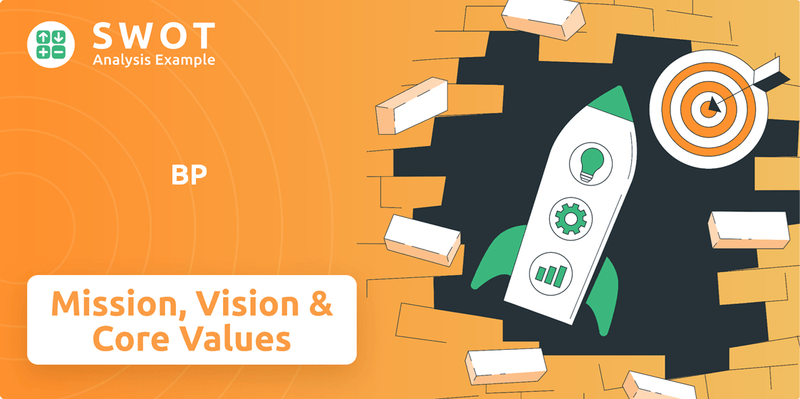
BP's commitment to its BP SWOT Analysis is a testament to the importance of these guiding principles. As BP, a major player in the energy sector, strives to balance current demands with a sustainable future, its mission, vision, and core values provide a roadmap. By examining these elements, we can better understand BP's goals and how it plans to achieve them in a dynamic global market, including its approach to environmental responsibility and corporate social responsibility.
Key Takeaways
- BP aims to provide energy while transitioning to a lower-carbon future.
- Key strengths include ambition, sustainable solutions, and core values.
- Alignment with guiding principles is crucial for future success.
- Navigating the energy transition requires innovation and stakeholder trust.
- BP's role extends beyond energy provision to encompass environmental and social responsibility.
Mission: What is BP Mission Statement?
BP's mission is 'to reimagine energy for people and our planet.'
Let's delve into the core of BP's purpose and strategic direction. Understanding the BP mission, BP vision, and BP core values is crucial for grasping the company's long-term objectives and its approach to navigating the evolving energy landscape. This section will provide a comprehensive analysis of BP's mission statement, its implications, and how it shapes the company's actions.
BP's mission statement, "to reimagine energy for people and our planet," encapsulates its dual focus. It highlights the commitment to both meeting current energy demands and investing in a sustainable future. This balance is key to understanding BP's strategy.
The mission statement targets a wide range of stakeholders. These include customers, shareholders, employees, and the communities in which BP operates. The "people and our planet" aspect underscores a commitment to broader societal and environmental responsibilities, which is also reflected in BP's environmental responsibility.
BP's offerings span traditional oil and gas products to sustainable energy solutions. This includes renewable energy sources, bioenergy, and technologies like carbon capture, utilization, and storage (CCUS). This diversification is central to BP's vision for the future.
BP operates globally, with a value proposition centered on reimagining energy and leading the transition to a low-carbon future. This is achieved while delivering value to its stakeholders. The company's global presence is a key factor in its impact on the energy sector.
BP's mission is reflected in its investments. For example, in 2024, BP invested $14.2 billion in oil and gas and $1.6 billion in low-carbon energy. The company is also targeting a 20% reduction in operational emissions by the end of 2025 (against a 2019 baseline). These actions exemplify examples of BP's mission in action.
The mission statement emphasizes balancing current energy needs with a focus on sustainability and innovation. This is a critical aspect of BP's strategic objectives. This approach also influences the company's approach to safety and ethics.
The BP company is actively working towards its goals. BP's commitment to sustainability is evident in its investments in renewable energy and its targets for emission reductions. This dual approach—investing in both current and future energy sources—is central to its mission. To understand the competitive landscape in which BP operates, consider reading about the Competitors Landscape of BP. This mission statement is a dynamic framework that guides BP's strategic decisions and its contribution to the global energy transition. The importance of BP's core values is also very important for the company's success.
BP SWOT Analysis
- Complete SWOT Breakdown
- Fully Customizable
- Editable in Excel & Word
- Professional Formatting
- Investor-Ready Format
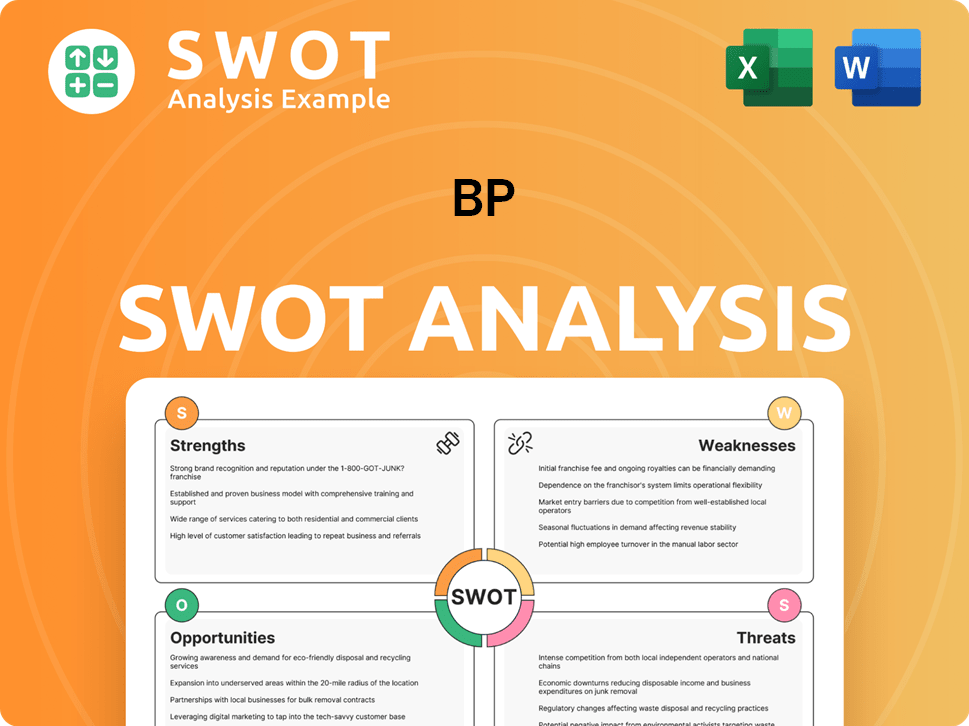
Vision: What is BP Vision Statement?
BP's vision is 'to lead the way in reimagining energy for people and our planet.'
The Owners & Shareholders of BP company's vision statement encapsulates its aspirations for the future, particularly within the dynamic energy sector. This statement reflects a commitment to innovation, sustainability, and global impact. Understanding this vision is crucial for investors, analysts, and stakeholders assessing BP's long-term strategy and its ability to navigate the evolving energy landscape. This section delves into the specifics of BP's vision, its implications, and its current trajectory.
BP's vision emphasizes leadership, positioning the company at the forefront of energy innovation. This involves pioneering new technologies and approaches to meet global energy demands. The company aims to shape the future of energy, rather than simply reacting to it.
A core element of BP's vision is its commitment to sustainability. This includes reducing carbon emissions and promoting environmentally responsible practices. BP aims to contribute to a more sustainable future through its operations and investments.
BP's vision extends beyond mere profitability, encompassing a broader societal impact. The company seeks to provide energy solutions that benefit people worldwide. This includes ensuring access to affordable and reliable energy sources.
The vision underscores the importance of diversifying energy sources and embracing innovation. This involves investing in renewable energy, developing new technologies, and exploring alternative fuel sources. BP aims to adapt to the changing energy landscape.
BP has set ambitious goals for reducing its carbon footprint, including a target to achieve net-zero emissions by 2050 or sooner. This commitment drives its investments in renewable energy and carbon reduction technologies. This includes reducing emissions from operations and assisting customers in lowering their carbon footprints.
Assessing the realism of BP's vision requires scrutiny of its strategic adjustments. Recent shifts in investment priorities, including increased spending on oil and gas and cuts in renewable energy investments, suggest a recalibration of its approach. From 2025 to 2027, BP plans to invest approximately $10 billion annually in oil and gas and $1.5 billion to $2 billion in energy transition activities. This revised approach, influenced by market conditions and financial performance, indicates a need to balance long-term ambitions with short-term realities. The company’s strategy is to balance its investments to ensure financial stability while still progressing toward its net-zero goals.
The BP vision is ambitious, aiming to redefine the energy sector. However, its realization depends on various factors, including technological advancements, market dynamics, and regulatory frameworks. The company's ability to balance its long-term goals with its short-term financial performance will be critical. The BP mission and BP core values serve as guiding principles, but strategic flexibility is essential in the rapidly evolving energy market. The company's success will be measured not only by its financial performance but also by its contribution to a sustainable future. Understanding BP's goals and BP's strategy is vital for anyone seeking to understand the company's future direction and its impact on the global energy landscape.
BP PESTLE Analysis
- Covers All 6 PESTLE Categories
- No Research Needed – Save Hours of Work
- Built by Experts, Trusted by Consultants
- Instant Download, Ready to Use
- 100% Editable, Fully Customizable
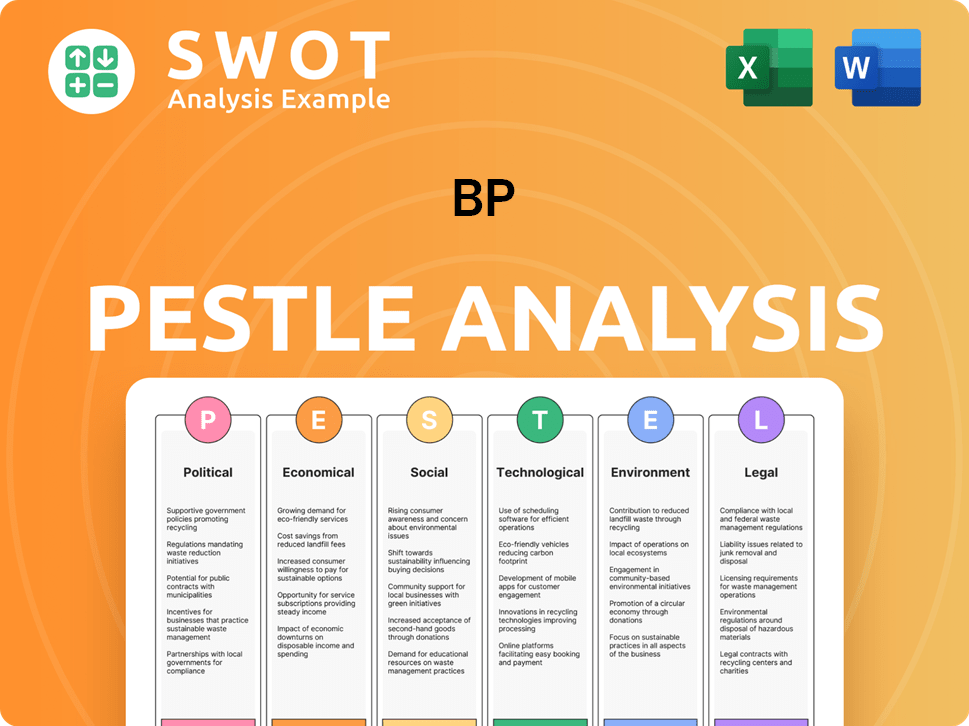
Values: What is BP Core Values Statement?
Understanding the core values of BP (formerly British Petroleum) is crucial for grasping its operational principles and its approach to the energy sector. These values guide the company's actions and shape its interactions with stakeholders, influencing everything from internal culture to external partnerships.
Safety is a paramount concern for BP, encompassing the well-being of its employees, contractors, and the communities where it operates. This commitment is evident in rigorous safety protocols and extensive training programs across all facets of its business, from exploration and production to refining and retail. For example, Lightsource bp, a significant part of BP's portfolio, prioritizes safety, aiming to eliminate fatalities and serious incidents. In 2023, BP invested approximately $1.5 billion in safety and operational risk management initiatives, reflecting its dedication to this core value.
BP fosters a culture of respect, valuing diversity, and inclusion, recognizing the contributions of every individual. This commitment is designed to create a work environment where all employees can thrive. BP's commitment to respect is demonstrated through various diversity and inclusion initiatives, aiming to build a more representative workforce. In 2023, BP reported that 40% of its global workforce are women, reflecting its ongoing efforts to promote diversity.
Integrity is a cornerstone of BP's operations, emphasizing honesty, transparency, and ethical conduct in all its dealings. This value underpins its business practices and customer relations, ensuring that the company consistently strives to "do the right thing." BP's commitment to integrity is reflected in its robust compliance programs and ethical guidelines, which are regularly reviewed and updated to meet evolving standards. In 2023, BP's ethics and compliance training reached over 95% of its global workforce, demonstrating its commitment to upholding the highest ethical standards.
BP encourages bold thinking and decisive action, fostering innovation and a willingness to pursue new energy solutions and navigate industry challenges. This value supports the company's strategic objectives and its commitment to a lower-carbon future. BP's investment in innovative technologies and renewable energy projects is a direct reflection of its commitment to courage and innovation. In 2023, BP invested over $5 billion in low-carbon energy projects, showcasing its commitment to its growth strategy and its vision for the future.
These core values of BP, including safety, respect, integrity, and courage, collectively shape its corporate identity and guide its strategic direction. They are fundamental to achieving its BP mission, vision, and long-term goals. Next, we will explore how the BP mission and vision influence the company's strategic decisions.
How Mission & Vision Influence BP Business?
BP's mission and vision statements are crucial in shaping its strategic direction, guiding decisions from investment choices to operational practices. The company's commitment to its stated goals directly influences its approach to the evolving energy landscape.
The influence of the BP company mission and vision is evident in its strategic initiatives. The ambition to achieve net-zero emissions by 2050 or sooner, and to help the world get to net zero, is a core driver of BP's strategy.
- Investments in renewable energy projects, such as wind and solar.
- Efforts to reduce operational emissions (Scope 1 and 2).
- Strategic decisions influenced by market conditions and financial performance.
- Acquisition of Lightsource bp to expand renewable energy presence.
BP's investment in renewable energy projects directly reflects its BP vision and BP goals. For instance, the acquisition of Lightsource bp, completed in October 2024, showcases a commitment to expanding its presence in solar and battery storage. This strategic move aligns with the company's broader objectives to diversify its energy portfolio and reduce its carbon footprint.
A key aspect of BP's mission is reducing its environmental impact. The company has set specific targets for emissions reduction, with a goal to reduce Scope 1 and 2 emissions by 20% by the end of 2025. In 2024, BP's combined Scope 1 and 2 emissions were 38% lower than in 2019, demonstrating progress towards these goals.
While the BP mission and BP vision provide a long-term framework, strategic decisions are also influenced by market conditions. A strategic reset announced in early 2025 adjusted investment priorities, increasing focus on oil and gas production. This shift highlights how financial performance and market dynamics can impact the execution of the company's mission.
The BP core values and long-term planning. The mission and vision statements provide a framework for decision-making and resource allocation, guiding the company's actions across all levels. This framework helps ensure that day-to-day operations align with the company's overarching goals.
Measuring the success of the BP strategy is complex, but progress towards emissions reduction targets and investments in lower-carbon energy sources are key indicators. The company's performance in these areas reflects its commitment to its mission and vision.
BP's mission and vision are not static; they evolve to reflect changing market conditions and strategic priorities. The strategic reset in early 2025 demonstrates the company's ability to adapt while remaining committed to its core objectives. This adaptability is crucial for long-term success in the dynamic energy sector.
The interplay between BP's mission, vision, and strategic decisions is a dynamic process, influenced by both internal goals and external factors. Understanding this relationship is key to evaluating BP's long-term prospects. Next, we will delve into the Core Improvements to the Company's Mission and Vision.
BP Business Model Canvas
- Complete 9-Block Business Model Canvas
- Effortlessly Communicate Your Business Strategy
- Investor-Ready BMC Format
- 100% Editable and Customizable
- Clear and Structured Layout
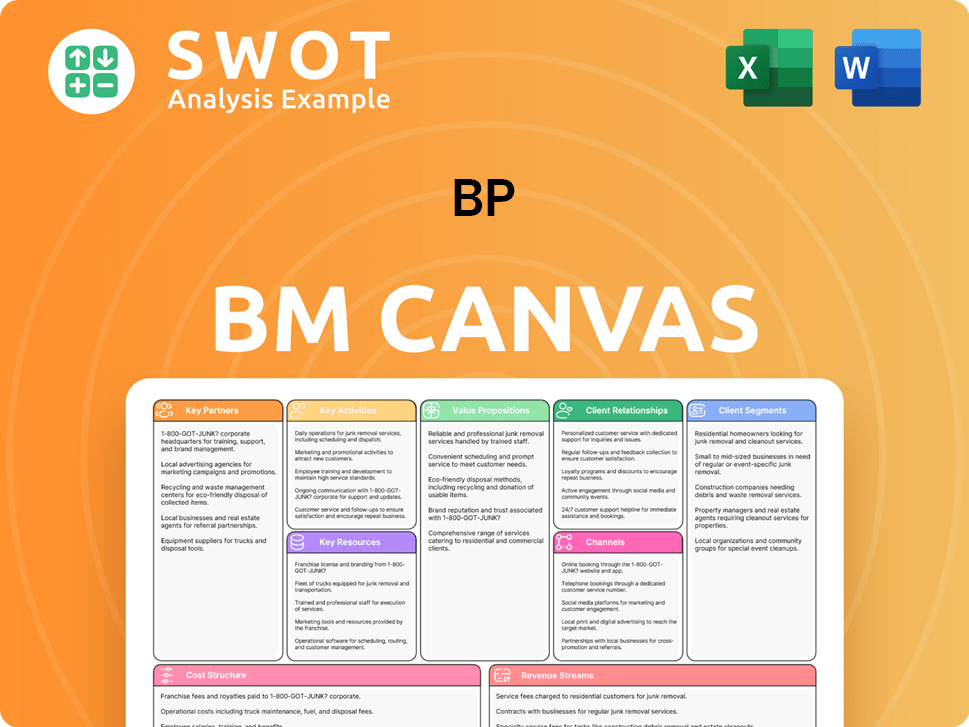
What Are Mission & Vision Improvements?
While BP's current statements lay a foundation for its future, there's always room for enhancement, particularly in light of the evolving energy landscape and stakeholder expectations. These improvements aim to strengthen the BP mission, vision, and core values, ensuring they remain relevant and impactful.
BP could significantly improve its mission and vision by providing a more detailed and transparent timeline for its energy transition goals. This includes setting specific, measurable, achievable, relevant, and time-bound (SMART) targets for reducing carbon emissions and increasing investments in renewable energy sources. For example, providing concrete milestones for increasing renewable energy capacity by 2030 and beyond would be beneficial. According to BP's 2024 Sustainability Report, the company aims to reduce oil and gas production by 25% by 2030, but further clarification on the intermediate steps and investments is needed to demonstrate a clear pathway.
Addressing stakeholder concerns regarding the balance between fossil fuel investments and lower-carbon initiatives is crucial. BP should explicitly state how it plans to manage its existing oil and gas assets while simultaneously scaling up its investments in renewable energy and other low-carbon technologies. This could involve outlining specific strategies for divesting from or repurposing high-carbon assets and allocating capital towards cleaner energy projects. BP's recent strategic adjustments, as highlighted in various financial reports, show a recalibration of investments; however, the mission and vision should reflect this balance more explicitly to build trust and transparency.
The BP vision should proactively incorporate emerging technologies such as hydrogen, carbon capture, and advanced biofuels. By explicitly mentioning these technologies and their role in the energy transition, BP can demonstrate its commitment to innovation and staying ahead of the curve. Furthermore, the vision should consider changing consumer behaviors and preferences, such as the growing demand for electric vehicles and sustainable energy solutions. For instance, the vision could be expanded to include goals related to expanding EV charging infrastructure or investing in sustainable aviation fuel, reflecting an understanding of the evolving Target Market of BP.
The BP mission and vision could be strengthened by more explicitly emphasizing its commitment to sustainability and environmental responsibility. This includes detailing specific environmental targets, such as reducing methane emissions and investing in biodiversity projects. BP should also enhance its communication on its environmental performance, providing regular updates on its progress towards its sustainability goals. For instance, BP's 2024 report may highlight a 15% reduction in operational emissions, but the mission and vision could provide more context and detail on the long-term implications of these efforts, and how they align with the company's core values.
How Does BP Implement Corporate Strategy?
Implementing BP's mission and vision is a continuous process that requires consistent effort across all levels of the organization. This involves translating the company's guiding principles into tangible actions and fostering a culture that reflects its core values.
Leadership plays a pivotal role in bringing the BP mission and vision to life. CEO Murray Auchincloss's emphasis on a "fundamental reset" of strategy, prioritizing cash flow and returns while maintaining the net-zero ambition, exemplifies this leadership.
- This strategic shift highlights the challenge of balancing financial performance with the energy transition.
- Auchincloss's approach is critical for guiding BP through the evolving energy landscape.
- The "fundamental reset" aims to streamline operations and improve efficiency.
BP actively demonstrates its mission and vision through strategic investments in lower-carbon energy projects. These initiatives are key to achieving BP's vision for the future and its long-term goals.
Lightsource bp's development of solar and battery storage assets exemplifies BP's commitment to diversifying energy sources. Efforts to reduce operational emissions, with a target for 2025, further demonstrate BP's environmental responsibility.
In 2024, BP invested $16 billion in transition growth areas. The company aims to reduce operational emissions by 30-35% by 2030 compared to 2019 levels. BP's strategic objectives include increasing renewable energy capacity.
BP communicates its mission, vision, and core values to stakeholders through various channels. The Annual Report and Form 20-F for 2024, published in March 2025, provides a comprehensive overview of the company's performance and strategy.
Ensuring alignment between stated values and actual business practices is crucial for maintaining credibility. BP's code of conduct guides ethical behavior and underscores its commitment to safety, ethics, and compliance.
- The Operating Management System (OMS) is used to embed safety and operational excellence.
- Recent job cuts, aimed at reducing costs, highlight the challenges of balancing strategic objectives with employee impact.
- BP's approach to safety and ethics is central to its operations.
BP Porter's Five Forces Analysis
- Covers All 5 Competitive Forces in Detail
- Structured for Consultants, Students, and Founders
- 100% Editable in Microsoft Word & Excel
- Instant Digital Download – Use Immediately
- Compatible with Mac & PC – Fully Unlocked
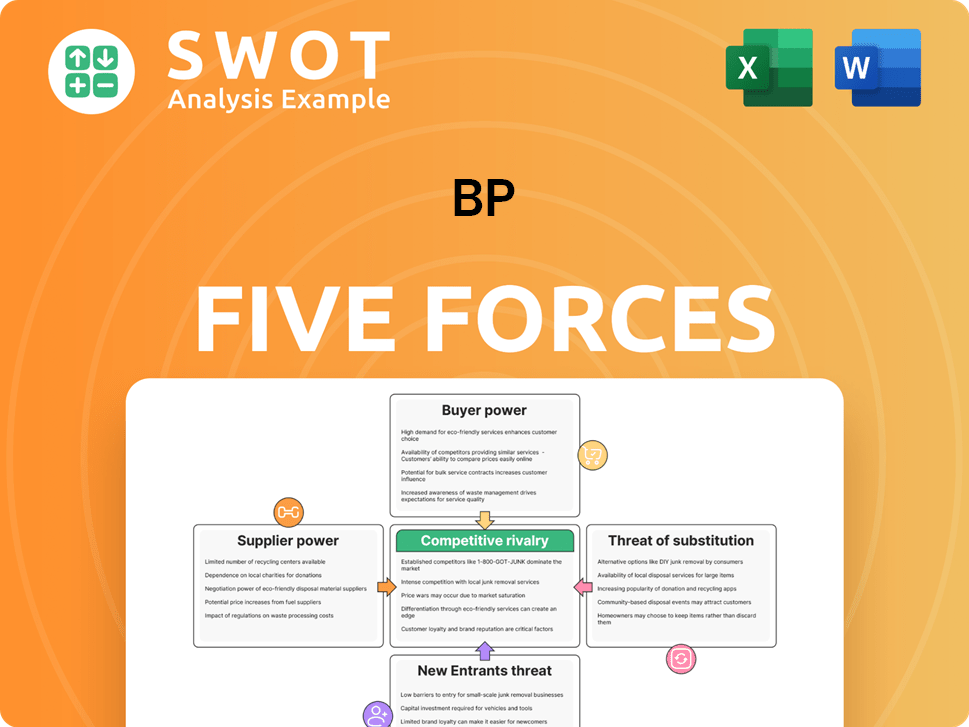
Related Blogs
- What are Mission Vision & Core Values of BP Company?
- What is Competitive Landscape of BP Company?
- What is Growth Strategy and Future Prospects of BP Company?
- How Does BP Company Work?
- What is Sales and Marketing Strategy of BP Company?
- Who Owns BP Company?
- What is Customer Demographics and Target Market of BP Company?
Disclaimer
All information, articles, and product details provided on this website are for general informational and educational purposes only. We do not claim any ownership over, nor do we intend to infringe upon, any trademarks, copyrights, logos, brand names, or other intellectual property mentioned or depicted on this site. Such intellectual property remains the property of its respective owners, and any references here are made solely for identification or informational purposes, without implying any affiliation, endorsement, or partnership.
We make no representations or warranties, express or implied, regarding the accuracy, completeness, or suitability of any content or products presented. Nothing on this website should be construed as legal, tax, investment, financial, medical, or other professional advice. In addition, no part of this site—including articles or product references—constitutes a solicitation, recommendation, endorsement, advertisement, or offer to buy or sell any securities, franchises, or other financial instruments, particularly in jurisdictions where such activity would be unlawful.
All content is of a general nature and may not address the specific circumstances of any individual or entity. It is not a substitute for professional advice or services. Any actions you take based on the information provided here are strictly at your own risk. You accept full responsibility for any decisions or outcomes arising from your use of this website and agree to release us from any liability in connection with your use of, or reliance upon, the content or products found herein.